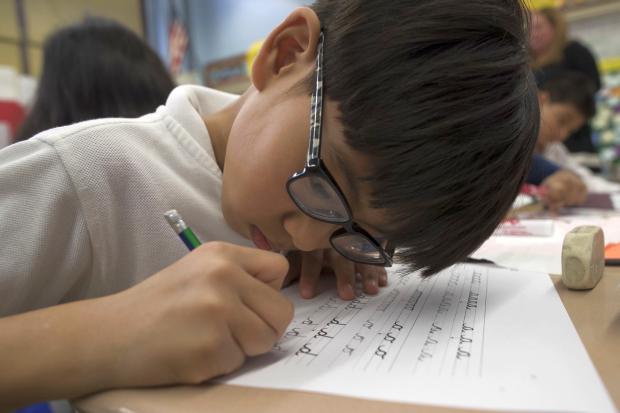
NEW YORK — Cursive writing is looping back into style in schools across the country after a generation of students who know only keyboarding, texting and printing out their words longhand.
Alabama and Louisiana passed laws in 2016 mandating cursive proficiency in public schools, the latest of 14 states that require cursive. And last fall, the 1.1 million-student New York City schools, the nation’s largest public school system, encouraged the teaching of cursive to students, generally in the third grade.
“It’s definitely not necessary but I think it’s, like, cool to have it,” said Emily Ma, a 17-year-old senior at New York City’s academically rigorous Stuyvesant High School who was never taught cursive in school and had to learn it on her own.
Penmanship proponents say writing words in an unbroken line of swooshing l’s and three-humped m’s is just a faster, easier way of taking notes. Others say students should be able to understand documents written in cursive, such as, say, a letter from Grandma. And still more say it’s just a good life skill to have, especially when it comes to signing your name.
That was where New York state Assemblywoman Nicole Malliotakis drew the line on the cursive generation gap, when she encountered an 18-year-old at a voter registration event who printed out his name in block letters.
“I said to him, ’No, you have to sign here,’” Malliotakis said. “And he said, ’That is my signature. I never learned script.’”
Malliotakis, a Republican from the New York City borough of Staten Island, took her concerns to city education officials and found a receptive audience.
Schools Chancellor Carmen Farina distributed a handbook on teaching cursive writing in September and is encouraging principals to use it. It cites research suggesting that fluent cursive helps students master writing tasks such as spelling and sentence construction because they don’t have to think as much about forming letters.
Malliotakis also noted that students who can’t read cursive will never be able to read historical documents. “If an American student cannot read the Declaration of Independence, that is sad.”
It’s hard to pinpoint exactly when cursive writing began to fall out of favor. But cursive instruction was in decline long before 2010, when most states adopted the Common Core curriculum standards, which say nothing about handwriting.
Some script skeptics question the advantage of cursive writing over printing and wonder whether teaching it takes away from other valuable instruction.
Anne Trubek, author of “The History and Uncertain Future of Handwriting,” said schools should not require cursive mastery any more than they should require all children to play a musical instrument.
“I think students would all benefit from learning the piano,” she said, “but I don’t think schools should require all students take piano lessons.”
At P.S. 166 in Queens, Principal Jessica Geller said there was never a formal decision over the years to banish the teaching of cursive. “We just got busy with the addition of technology, and we started focusing on computers,” she said.
Third-graders at the school beamed as they prepared for a cursive lesson this past week. The 8-year-olds got their markers out, straightened their posture and flexed their wrists. Then it was “swoosh, curl, swoosh, curl,” as teacher Christine Weltner guided the students in writing linked-together c’s and a’s.
Norzim Lama said he prefers cursive writing to printing “’cause it looks fancy.” Camille Santos said cursive is “actually like doodling a little bit.”
Added Araceli Lazaro: “It’s a really fascinating way to write, and I really think that everybody should learn about writing in script.” –Karen Matthews